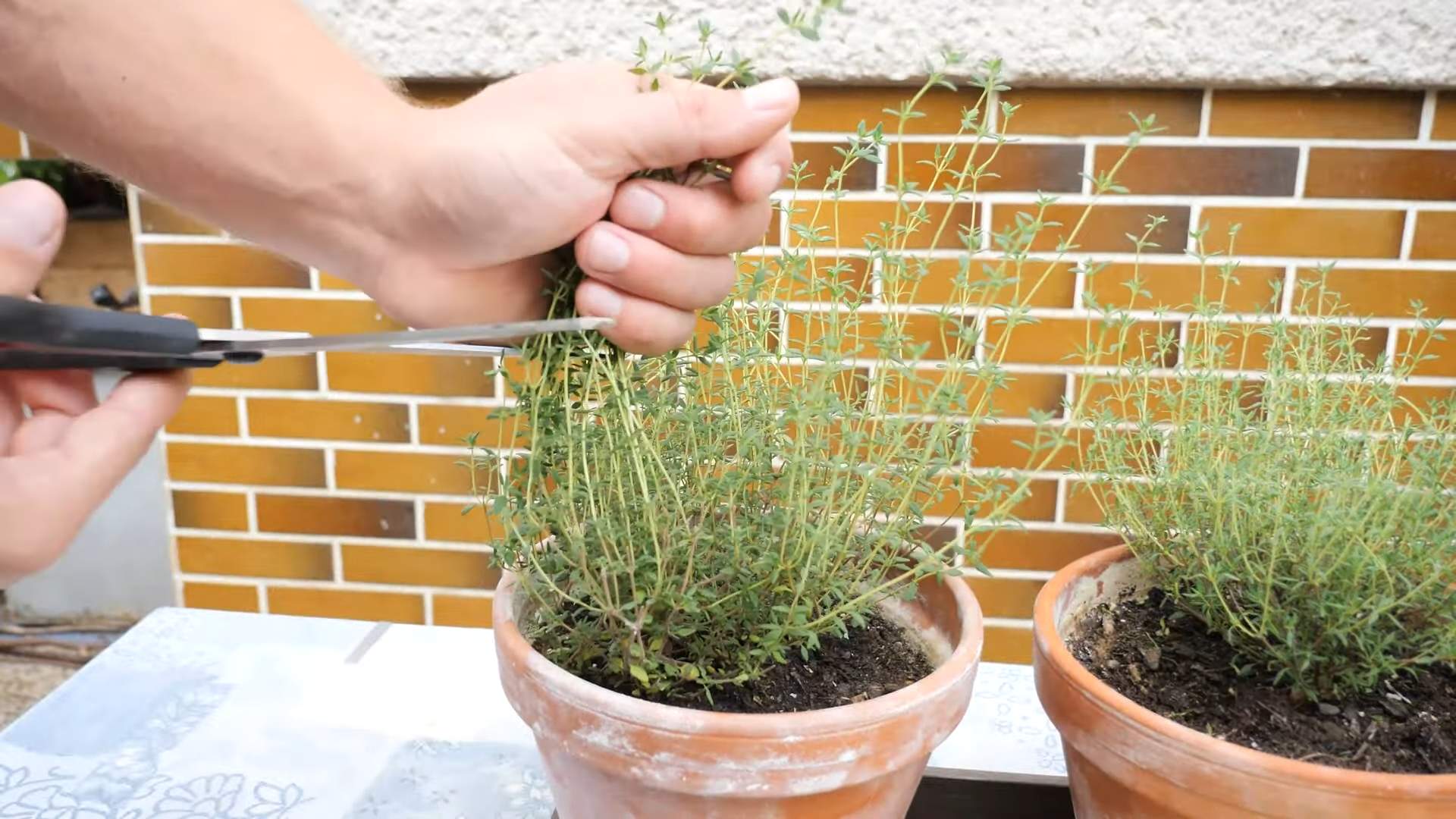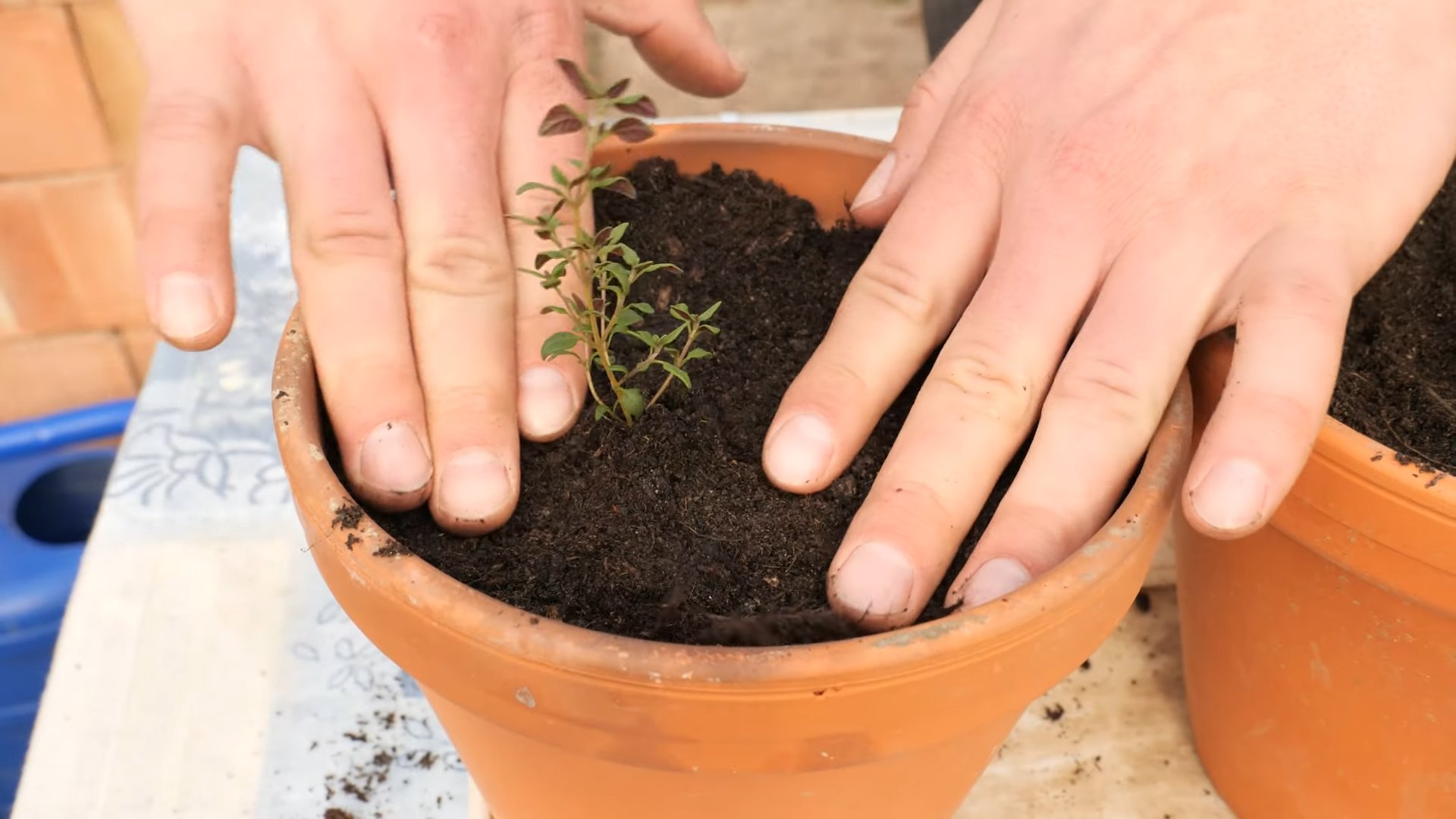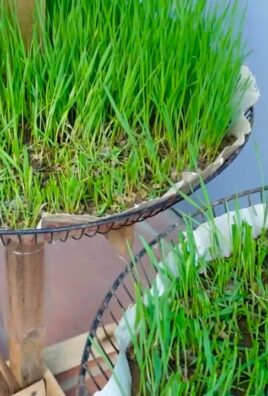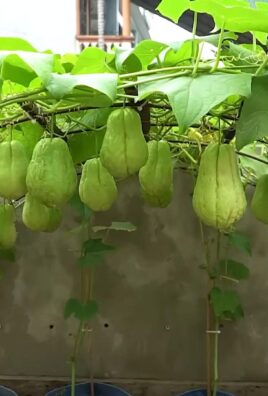Grow Thyme Indoors? Absolutely! Imagine having fresh, fragrant thyme right at your fingertips, ready to elevate your culinary creations any time of year. Forget those sad, wilted sprigs from the grocery store – we’re talking vibrant, flavorful thyme grown with your own two hands, right in your home!
Thyme, with its rich history dating back to ancient Egypt where it was used for embalming, and later by the Greeks and Romans for its medicinal properties and aromatic qualities, has always been a valued herb. For centuries, it’s been a symbol of courage and strength. But you don’t need to be a seasoned gardener to enjoy its benefits.
In today’s busy world, access to fresh herbs can be a challenge. That’s where this DIY guide comes in! Learning how to grow thyme indoors is not only incredibly rewarding, but it’s also a fantastic way to add a touch of green to your living space, reduce your reliance on store-bought herbs, and save money in the long run. Plus, the delightful aroma of thyme will fill your home with a calming, earthy scent. I’m going to share some simple, effective tricks and hacks that will have you harvesting your own homegrown thyme in no time. Let’s get started!

Growing Thyme Indoors: A Comprehensive DIY Guide
Hey there, fellow plant enthusiasts! I’m so excited to share my tried-and-true method for growing thyme indoors. Fresh thyme is a game-changer in the kitchen, and having it readily available is a real treat. Plus, the aroma is just divine! This guide will walk you through everything you need to know, from choosing the right thyme variety to harvesting your fragrant bounty. Let’s get started!
Choosing Your Thyme Variety
Before we dive into the nitty-gritty, let’s talk thyme varieties. Not all thyme is created equal, and some are better suited for indoor growing than others. Here are a few of my favorites:
* **English Thyme (Thymus vulgaris):** This is your classic culinary thyme. It has a strong, earthy flavor and is perfect for soups, stews, and roasted meats. It’s also relatively easy to grow indoors.
* **Lemon Thyme (Thymus citriodorus):** As the name suggests, this thyme has a delightful lemon scent and flavor. It’s fantastic in teas, salads, and fish dishes. It tends to be a bit more delicate than English thyme, so it needs a little extra TLC.
* **Creeping Thyme (Thymus serpyllum):** While primarily used as a ground cover outdoors, creeping thyme can also thrive indoors. It has a milder flavor and is great for adding a subtle herbal note to your cooking. Plus, it looks beautiful cascading over the edge of a pot.
I personally prefer English Thyme for its robust flavor and ease of care, but feel free to experiment and find the variety that suits your taste!
Gathering Your Supplies
Okay, now that we’ve chosen our thyme, let’s gather our supplies. Here’s what you’ll need:
* **Thyme Seeds or a Thyme Plant:** You can start from seeds or purchase a small thyme plant from your local nursery. Starting from seeds takes longer, but it’s more cost-effective.
* **Potting Mix:** Use a well-draining potting mix specifically formulated for herbs. Avoid using garden soil, as it can become compacted and doesn’t drain well.
* **Pot:** Choose a pot that’s at least 6 inches in diameter with drainage holes. Thyme doesn’t like to sit in soggy soil. Terracotta pots are a great option because they allow the soil to breathe.
* **Grow Lights (Optional but Recommended):** While thyme loves sunlight, it can be challenging to provide enough natural light indoors, especially during the winter months. Grow lights will ensure your thyme gets the light it needs to thrive.
* **Watering Can or Spray Bottle:** For gentle watering.
* **Scissors or Pruning Shears:** For harvesting and pruning.
* **Small Shovel or Trowel:** For planting.
Planting Your Thyme
Alright, let’s get our hands dirty! Here’s how to plant your thyme:
Starting from Seeds:
1. **Prepare the Pot:** Fill your pot with potting mix, leaving about an inch of space at the top. Gently pat down the soil.
2. **Sow the Seeds:** Sprinkle the thyme seeds evenly over the surface of the soil. Thyme seeds are tiny, so don’t overdo it.
3. **Cover the Seeds:** Lightly cover the seeds with a thin layer of potting mix.
4. **Water Gently:** Use a spray bottle to mist the soil. You want to keep the soil moist but not soggy.
5. **Provide Light:** Place the pot in a bright location or under grow lights.
6. **Maintain Moisture:** Keep the soil consistently moist until the seeds germinate, which usually takes about 14-21 days. You can cover the pot with plastic wrap to help retain moisture, but be sure to remove it once the seedlings emerge.
Planting a Thyme Plant:
1. **Prepare the Pot:** Fill your pot with potting mix, leaving about an inch of space at the top.
2. **Remove the Thyme Plant from its Container:** Gently squeeze the sides of the container to loosen the plant. Carefully remove the plant, being careful not to damage the roots.
3. **Loosen the Roots:** Gently loosen the roots of the thyme plant. If the roots are tightly bound, you can use your fingers to gently separate them.
4. **Plant the Thyme:** Place the thyme plant in the center of the pot. Make sure the top of the root ball is level with the surface of the soil.
5. **Fill with Soil:** Fill in the remaining space around the plant with potting mix. Gently pat down the soil.
6. **Water Thoroughly:** Water the thyme plant thoroughly until water drains out of the drainage holes.
Caring for Your Indoor Thyme
Now that your thyme is planted, it’s time to learn how to care for it. Here’s what you need to know:
Light:
Thyme needs at least 6-8 hours of sunlight per day. If you don’t have a sunny window, use grow lights to supplement the natural light. I’ve found that using a full-spectrum LED grow light for 12-14 hours a day works wonders.
Watering:
Thyme is drought-tolerant, so it’s important not to overwater it. Allow the soil to dry out slightly between waterings. When you do water, water thoroughly until water drains out of the drainage holes. Avoid getting the leaves wet, as this can lead to fungal diseases. I usually water my thyme about once a week, but this will vary depending on the humidity and temperature in your home.
Temperature:
Thyme prefers temperatures between 60-70°F (15-21°C). Avoid placing your thyme near drafts or heat sources.
Fertilizing:
Thyme doesn’t need a lot of fertilizer. In fact, too much fertilizer can actually make it less flavorful. I fertilize my thyme about once a month with a diluted liquid fertilizer specifically formulated for herbs.
Pruning:
Pruning is essential for keeping your thyme healthy and productive. Prune your thyme regularly to encourage new growth and prevent it from becoming leggy. Simply snip off the tips of the stems with scissors or pruning shears. You can also remove any dead or yellowing leaves.
Harvesting Your Thyme
The best part about growing thyme indoors is being able to harvest fresh thyme whenever you need it! Here’s how to harvest your thyme:
1. **Wait Until the Plant is Established:** Don’t start harvesting until your thyme plant is at least 4-6 inches tall.
2. **Harvest in the Morning:** Harvest your thyme in the morning, after the dew has dried. This is when the essential oils are most concentrated, resulting in the best flavor.
3. **Use Scissors or Pruning Shears:** Use scissors or pruning shears to snip off the stems.
4. **Harvest Regularly:** Harvest your thyme regularly to encourage new growth. You can harvest up to one-third of the plant at a time.
Troubleshooting Common Problems
Even with the best care, you may encounter some problems when growing thyme indoors. Here are a few common issues and how to fix them:
* **Yellowing Leaves:** This can be caused by overwatering, underwatering, or nutrient deficiencies. Check the soil moisture and adjust your watering accordingly. If the soil is dry, water thoroughly. If the soil is soggy, allow it to dry out before watering again. You can also try fertilizing your thyme with a diluted liquid fertilizer.
* **Leggy Growth:** This is usually caused by insufficient light. Move your thyme to a brighter location or use grow lights to supplement the natural light. Prune your thyme regularly to encourage bushier growth.
* **Pests:** Thyme is relatively pest-resistant, but it can occasionally be infested with aphids or spider mites. If you notice pests, spray your thyme with insecticidal soap.
* **Fungal Diseases:** Fungal diseases can be caused by overwatering or poor air circulation. Avoid getting the leaves wet when watering and ensure your thyme has good air circulation. If you notice signs of fungal disease, such as powdery mildew, remove the affected leaves and spray your thyme with a fungicide.
Enjoying Your Homegrown Thyme
Now that you’ve successfully grown and harvested your own thyme, it’s time to enjoy the fruits (or rather, herbs) of your labor! Here are a few ways to use your homegrown thyme:
* **Fresh:** Use fresh thyme in soups, stews, roasted meats, vegetables, and salads.
* **Dried:** Dry your thyme by hanging it upside down in a cool, dry place. Once it’s completely dry, store it in an airtight container.
* **Infused Oil:** Infuse olive oil with thyme for a flavorful cooking oil.
* **Herbal Tea:** Steep fresh or dried thyme in hot water for a soothing herbal tea.
Growing thyme indoors is a rewarding experience that will provide you with fresh, flavorful herbs year-round. With a little care and attention,

Conclusion
So, there you have it! Growing thyme indoors is not only achievable, but it’s also incredibly rewarding. Imagine having fresh, fragrant thyme readily available, no matter the season, to elevate your culinary creations. Forget those sad, dried-out jars of herbs from the supermarket – with a little effort, you can cultivate your own thriving thyme plant right on your windowsill.
This DIY trick is a must-try for several reasons. First, it’s incredibly cost-effective. A single packet of thyme seeds or a small starter plant is far cheaper than constantly buying fresh thyme from the grocery store. Second, it’s environmentally friendly. You’re reducing your carbon footprint by eliminating the need for transportation and packaging associated with store-bought herbs. Third, and perhaps most importantly, it’s incredibly satisfying. There’s something truly special about nurturing a plant from seed to harvest, and the fresh, vibrant flavor of homegrown thyme is simply unmatched.
But don’t stop there! Once you’ve mastered the art of growing thyme indoors, consider experimenting with different varieties. Lemon thyme adds a bright, citrusy note to dishes, while creeping thyme is perfect for ground cover (though perhaps not ideal for indoor pots!). You can also try propagating your thyme plant through cuttings to expand your herb garden even further. Another variation is to experiment with different types of containers. While terracotta pots are excellent for drainage, you might find that self-watering containers make the process even easier, especially if you’re prone to forgetting to water your plants.
Growing thyme indoors is a game-changer for any home cook. It’s a simple, sustainable, and satisfying way to add fresh flavor to your meals. We wholeheartedly encourage you to give this DIY trick a try. We are confident that you’ll be amazed at how easy and rewarding it is.
And once you’ve harvested your first batch of homegrown thyme, we’d love to hear about your experience! Share your tips, tricks, and photos in the comments below. Let’s build a community of indoor thyme growers and inspire others to embrace the joy of fresh, homegrown herbs. What dishes did you make with your fresh thyme? Did you encounter any challenges, and how did you overcome them? Your insights could be invaluable to other aspiring indoor gardeners. So, go ahead, get your hands dirty, and start growing thyme indoors today! You won’t regret it.
Frequently Asked Questions (FAQ)
What kind of thyme is best for growing indoors?
While most varieties of thyme can be grown indoors, some are better suited than others. Common thyme (Thymus vulgaris) is a popular choice due to its versatility and robust flavor. Lemon thyme (Thymus citriodorus) is another excellent option, offering a delightful citrusy aroma and flavor. Creeping thyme (Thymus serpyllum), while beautiful, is more suited for ground cover and may not thrive as well in a pot indoors. Consider the flavor profile you prefer and the space you have available when choosing your thyme variety.
How much sunlight does indoor thyme need?
Thyme thrives in bright, sunny conditions. Ideally, your indoor thyme plant should receive at least 6-8 hours of direct sunlight per day. A south-facing window is usually the best option. If you don’t have access to enough natural light, you can supplement with a grow light. Position the grow light a few inches above the plant and keep it on for 12-14 hours per day. Insufficient sunlight can lead to leggy growth and a weaker flavor.
What kind of soil should I use for growing thyme indoors?
Thyme prefers well-draining soil. A mixture of potting soil, perlite, and sand is ideal. This combination provides good drainage and aeration, preventing the roots from becoming waterlogged. Avoid using heavy, clay-based soils, as they can retain too much moisture and lead to root rot. You can also purchase a pre-made herb potting mix, which is specifically formulated for herbs like thyme.
How often should I water my indoor thyme plant?
Water your thyme plant when the top inch of soil feels dry to the touch. Avoid overwatering, as this can lead to root rot. Thyme prefers slightly dry conditions. When you do water, water thoroughly until water drains out of the bottom of the pot. Make sure the pot has drainage holes to prevent water from accumulating at the bottom. During the winter months, when the plant is not actively growing, you may need to water less frequently.
How do I fertilize my indoor thyme plant?
Thyme is not a heavy feeder and doesn’t require frequent fertilization. However, you can fertilize your plant every few months with a diluted liquid fertilizer specifically formulated for herbs. Follow the instructions on the fertilizer packaging carefully to avoid over-fertilizing, which can damage the plant. Alternatively, you can add a small amount of compost to the soil when you repot your thyme plant.
How do I harvest thyme from my indoor plant?
You can start harvesting thyme once the plant is established and has grown to a reasonable size. Use sharp scissors or pruning shears to snip off stems as needed. Avoid cutting more than one-third of the plant at a time, as this can stress the plant. Regular harvesting encourages bushier growth. You can use the fresh thyme immediately or dry it for later use. To dry thyme, hang the stems upside down in a cool, dry place until they are completely dry.
How do I propagate thyme from cuttings?
Propagating thyme from cuttings is a simple and effective way to expand your herb garden. Take a 4-6 inch cutting from a healthy thyme plant, removing the lower leaves. Dip the cut end in rooting hormone (optional) and plant it in a small pot filled with well-draining potting mix. Water the cutting and cover it with a plastic bag or humidity dome to create a humid environment. Keep the cutting in a warm, bright location, but out of direct sunlight. After a few weeks, the cutting should develop roots. Once the roots are established, you can transplant the new thyme plant into a larger pot.
Why is my indoor thyme plant turning yellow?
Yellowing leaves can be a sign of several problems, including overwatering, underwatering, nutrient deficiency, or pest infestation. Check the soil moisture to determine if you are watering too much or too little. If the soil is consistently wet, reduce your watering frequency. If the soil is dry, water more thoroughly. If you suspect a nutrient deficiency, fertilize your plant with a diluted liquid fertilizer. Inspect the plant for pests, such as aphids or spider mites, and treat accordingly.
My thyme plant is leggy and not bushy. What can I do?
Leggy growth is often caused by insufficient sunlight. Move your thyme plant to a sunnier location or supplement with a grow light. Pruning the plant regularly can also encourage bushier growth. Pinch back the tips of the stems to promote branching.
Can I grow thyme indoors year-round?
Yes, you can grow thyme indoors year-round, provided you provide the plant with adequate sunlight, water, and well-draining soil. During the winter months, the plant may grow more slowly, but it should still thrive with proper care.




Leave a Comment